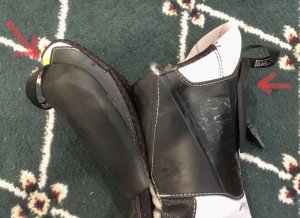- Joined
- Dec 21, 2015
- Posts
- 4,123
I use mine to mold, then take them out. Again super wide calf even below the muscle.
Last edited:
It all depends...depends on the individual's morphology, the binding delta, the boot shaft angle, the individual's preference. There is no one right answer.
We have a winner! Adding the spoiler effectively increases the forward angle of the rear spine. This increases knee flexion and ankle flexion and in turn, hip flexion. Depending on the diameter of your calf at the top of the boot, this may be a little or a lot.
Do you want/ need or would benefit from more bend in your stance or less?
In general, taller people with longer, skinny legs are more likely to benefit from the addition of the spoiler than those with shorter sturdier legs.
Personally, it is pretty rare that I see the need to add forward lean to an clients boot. Particularly, in light of the angles of most bindings.
As a space filler sometimes, but to add more flexion, not so much.
Obviously, your results may vary. This is as it should be.
pliny the elder
Great explanation so excuse this stupid question. If the spoiler is used to take up volume but inadvertently increase forward angle, is it sometimes necessary to make other adjustments to decrease forward angle?
I'm interested in what the bootfitters say about this.For those of you who are after more forward lean, or for bootfitters reading this thread, how do spoilers compare to gas pedals for this task? Do they share the same pros and cons?
In my case it may be that the combination of tongue shim & spoiler almost cancel each other out.Great explanation so excuse this stupid question. If the spoiler is used to take up volume but inadvertently increase forward angle, is it sometimes necessary to make other adjustments to decrease forward angle?

I connected adding a gas pedal to adding forward lean because so many people here have posted that gas pedaling causes a skier to squat low. I'm assuming squatting low means ankles are dorsiflexing more, increasing forward lean of lower leg, to counteract the effect of the riser under the toe lugs.Gas pedal takes away the existing forward lean.....
This is the biggest reason.With my chicken legs? I need the volume taken up.
It all depends...depends on the individual's morphology, the binding delta, the boot shaft angle, the individual's preference. There is no one right answer.